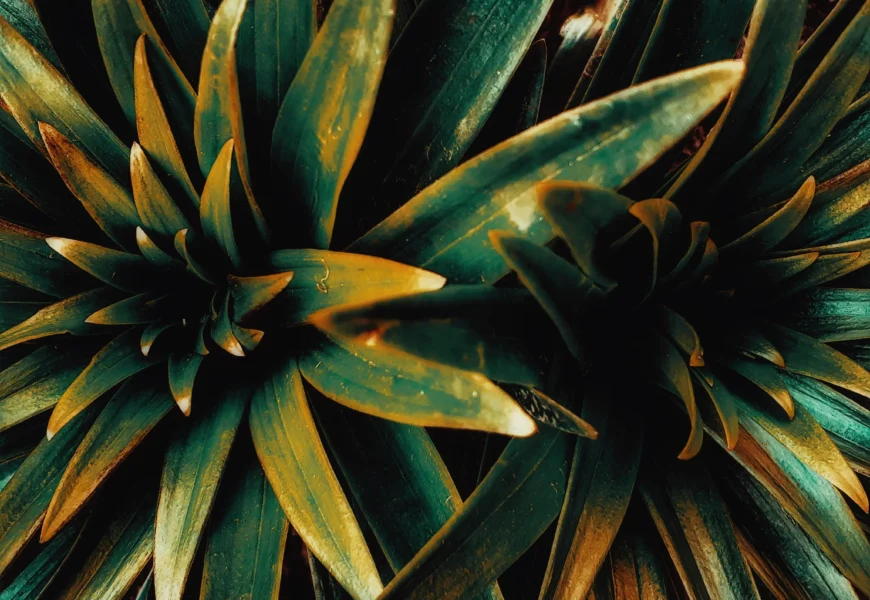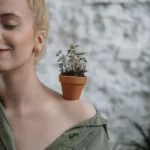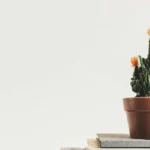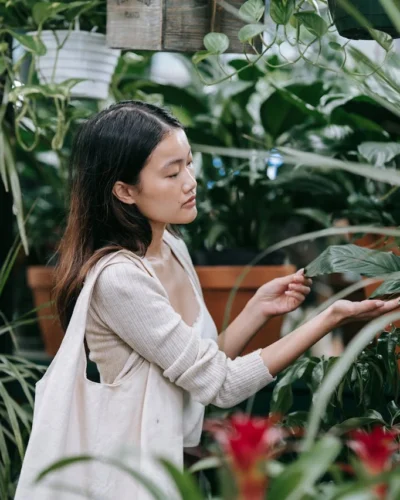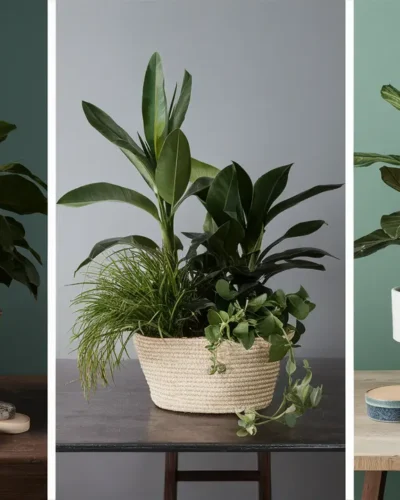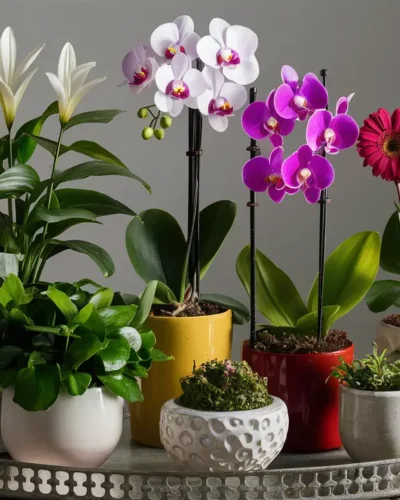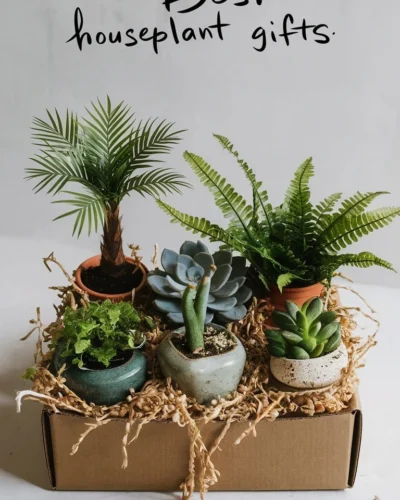Are you looking to add a touch of the wild to your home? Large houseplants can transform a space, bringing a sense of grandeur and tranquility. They’re like living sculptures, gracing your home with their presence. But before you bring home a leafy behemoth, it’s essential to know what you’re getting into. This guide will help you choose the right large houseplants, care for them with love, and style them to perfection.
Table of Content
Here’s what we’ll cover:
Choosing the Right Giant: A Look at Popular Large Houseplants – Learn about popular choices like the Fiddle Leaf Fig, Monstera Deliciosa, and the mighty Bird of Paradise. We’ll discuss their unique characteristics, growth habits, and what makes them ideal for specific environments.
Beyond the Basics: Caring for Your Large Houseplant – Watering, light, and fertilizing are key to a thriving giant. This section will delve into the specific needs of different large houseplants, helping you understand the best practices for each
Space Planning & Placement: Finding the Perfect Spot for Your Giant Friend – Large plants need space to grow! This section will guide you on selecting the right spot in your home based on your plant’s specific needs and your desired aesthetic.
Troubleshooting: Common Issues and Solutions – Yellowing leaves, drooping stems, and pests are common problems with large houseplants. This section will provide you with practical solutions to keep your giant friend flourishing.
Bringing the Outdoors In: Styling Your Giant Houseplants – Enhance your space with a touch of natural charm by learning how to style your large houseplants. We’ll explore different pots, accessories, and design tips to create a truly unique and stylish interior.
Let’s get started on your journey to becoming a giant plant parent!
1. Choosing the Right One: A Look at Popular Large Houseplants
The world of large houseplants is vast and full of beauty, offering something for every taste. Here are a few popular options that are known for their size, adaptability, and stunning foliage:
1. Fiddle Leaf Fig (Ficus lyrata): This elegant beauty boasts large, fiddle-shaped leaves with prominent veins. The Fiddle Leaf Fig can reach impressive heights indoors, adding a touch of sophistication and drama to any room. They prefer bright, indirect light and well-draining soil. While known for their stately presence, they can be a bit finicky, so be prepared to give them the royal treatment!
2. Monstera Deliciosa: This tropical stunner is known for its iconic, perforated leaves that give it a distinct and captivating look. The Monstera Deliciosa thrives in bright, indirect light and enjoys a humid environment. They are relatively easy to care for and can tolerate some neglect, making them a great choice for beginner plant parents.
3. Bird of Paradise (Strelitzia reginae): This plant truly lives up to its name, boasting exotic, bird-like blooms that add a vibrant splash of color to your home. The Bird of Paradise prefers bright, indirect light and well-draining soil. They can grow quite large and are known for their dramatic, architectural foliage.
4. ZZ Plant (Zamioculcas zamiifolia): Known for its resilience and low-maintenance nature, the ZZ plant is a perfect option for those who are new to plant parenting or who have a busy lifestyle. This plant can tolerate low light conditions and infrequent watering, making it a reliable choice for even the most forgetful plant enthusiast.
5. Rubber Tree (Ficus elastica): The Rubber Tree is known for its glossy, leathery leaves that can grow incredibly large. They are available in a variety of varieties, offering different leaf colors and patterns. Rubber trees are adaptable plants that can tolerate a range of light conditions and are relatively easy to care for.
Beyond their visual appeal, these giants offer a multitude of benefits:
- Air Purification: Large houseplants are natural air purifiers, absorbing toxins and releasing clean oxygen, making your home healthier and more comfortable.
- Stress Relief: Studies show that being around plants can reduce stress and anxiety, promoting a sense of calmness and well-being.
- Improved Mood: Having large houseplants around can brighten your mood and create a more welcoming atmosphere.
- Increased Productivity: The presence of plants can enhance focus and productivity, making them ideal for home offices or study spaces.
Choosing the right giant for your home is crucial. Consider the amount of light available, the space you have, and your personal preferences. Remember, a large houseplant is a significant commitment, but it can be a rewarding one!
2. Caring for Your Large Houseplant
Now that you’ve chosen your giant green friend, let’s talk about keeping it happy and thriving. Caring for large houseplants might seem intimidating, but it’s actually quite simple once you understand their basic needs.
Light: Giving Your Giant Friend the Right Glow
Like all plants, large houseplants need sunlight to photosynthesize and produce energy. The amount of light they need varies depending on the species. Some, like the Fiddle Leaf Fig, prefer bright, indirect light while others, like Snake Plants, can tolerate lower light conditions.
Here’s a simple guide:
- Bright, Indirect Light: Think of a well-lit room with curtains that filter out the harshest rays of the sun.
- Medium Light: A room with some natural light coming in but not directly hitting the plant.
- Low Light: A room with minimal natural light, often relying on artificial light sources.
Don’t be afraid to experiment! If you notice your large houseplant isn’t thriving in its current spot, try moving it to a different location with more or less light.
Watering: The Art of Hydrating Your Green Giant
Overwatering is a common mistake with large houseplants, so it’s crucial to find the right watering frequency. Here’s a general rule of thumb:
- Check the soil: Stick your finger into the soil about an inch deep. If it feels dry, it’s time to water.
- Don’t overwater: Let the top inch of soil dry out between waterings.
- Drain the excess: Make sure your pot has drainage holes and that you’re not allowing water to sit at the bottom.
Remember, each large houseplant has its own personality when it comes to watering. Some, like ZZ Plants, are very drought-tolerant and can go weeks without water, while others, like Monsteras, prefer more frequent watering.
For more specific tips on caring for your chosen houseplant, you can always consult our Beginner’s Guide to Houseplants.
Fertilizing: Giving Your Giant the Nutrients It Needs
Just like us, large houseplants need a little boost of nutrients to stay healthy. Fertilizing can help them grow strong and vibrant.
- Choose the right fertilizer: Look for a balanced fertilizer specifically designed for houseplants.
- Follow the instructions: Don’t overdo it! Overfertilizing can actually harm your plant.
- Fertilize during the growing season: Most houseplants thrive during the spring and summer months.
For more detailed information on how to fertilize your large houseplants without harming them, check out our Guide to Houseplant Pests.
Repotting: Giving Your Giant Room to Grow
As your large houseplant grows, it’s important to give it a larger pot to accommodate its root system. Here’s how to know when it’s time to repot:
- The roots are coming out of the drainage holes: This is a clear sign your plant needs a bigger pot.
- The plant is starting to get rootbound: You can see the roots circling around the inside of the pot.
- The plant isn’t growing as much as it used to: This could be a sign that it’s struggling for space.
When repotting, choose a pot just slightly larger than the current one and use fresh potting mix.
Tips for Keeping Your Giant Happy
Here are a few extra things you can do to ensure your large houseplant is thriving:
- Regularly check for pests: Inspect your plant for any signs of insects or diseases.
- Dust the leaves: Dust can accumulate on the leaves, hindering their ability to absorb sunlight.
- Give it a shower: Sometimes, a good shower can help clear out dust and refresh the plant.
With a little care and attention, your large houseplants will become treasured members of your home, bringing a touch of the outdoors inside and providing a sense of tranquility and peace. Remember, your large houseplants are living beings with their own needs and personalities. By learning to understand and care for them, you’ll be rewarded with beautiful, healthy plants that will bring joy for years to come.
3. Finding the Perfect Spot for Your Large Houseplants
Now that you’ve chosen your large houseplant companion, it’s time to find the perfect spot for it to thrive! These giants need room to grow, both in terms of physical space and the right conditions.
Sunlight is Key: Large houseplants are often sun-lovers, but different species have varying needs. Before bringing your new friend home, consider where you’ll place it and assess the amount of sunlight that spot receives. A window facing south or west typically offers the most sunlight, while north-facing windows provide less direct light. The Green Therapy: Why My Houseplants Make Me Happy
Room to Breathe: These plants are, well, large! Make sure they have ample space to spread out their leaves and roots without being crowded. Avoid placing them near doorways or high-traffic areas where they could be bumped or knocked over.
Consider the Ceiling: It’s important to choose a spot where your large houseplant has enough vertical space to grow. Some plants can reach impressive heights, so be mindful of your ceiling height!
Humidity is Important: Many large houseplants prefer humid environments. If you live in a dry climate, you may need to provide extra humidity to your plant. You can do this by placing a humidifier nearby, grouping your plants together, or using a pebble tray. Say Goodbye to Spider Mites: A Complete Guide to Saving Your Houseplants
Airflow is Essential: Make sure your plant is placed in a spot with good airflow. This will help to prevent diseases and pests. Avoid placing your plant in a spot that is too close to a heater or air conditioner.
Safety First: If you have pets or children, be sure to choose a spot for your large houseplant that is out of their reach. Some plants can be toxic if ingested, so it’s important to take safety precautions.
By carefully considering the needs of your large houseplant, you can find the perfect spot for it to flourish in your home.
4. Troubleshooting and Common Issues and Solutions
Bringing a large houseplant into your home is a big commitment, but one that can be incredibly rewarding. Like any relationship, caring for your giant green friend comes with its share of ups and downs. Sometimes you might notice changes in your plant that make you worry. Don’t fret! Here’s a guide to common issues and how to address them:
1. Leaf Drop:
While some leaf loss is normal, especially during the transition seasons, excessive shedding can signal a problem. The most common culprits are:
- Underwatering: Check the soil moisture. Large plants have big appetites and need consistent hydration.
- Overwatering: This is often the culprit for root rot, which leads to leaf drop. Check for soggy soil, and consider repotting with fresh soil.
- Temperature Shock: Sudden changes in temperature can stress your plant, leading to leaf drop. Try to maintain a consistent temperature, especially during the winter months.
- Light Issues: Your plant might be getting too much or too little light. Adjust its position based on its specific light needs.
2. Yellowing Leaves:
Yellow leaves are a common sign of nutrient deficiencies, which is particularly common with large plants that require frequent feeding.
- Nutrient Deficiency: Start by providing a balanced fertilizer specifically formulated for houseplants.
- Overwatering: This can lead to root rot, which hinders nutrient absorption.
- Chlorosis: This is a condition where the plant can’t produce chlorophyll, resulting in yellowing. It can often be addressed with an iron supplement.
3. Pests:
Unfortunately, your giant houseplant can be a tempting target for various pests, especially if it’s located near other plants.
- Spider Mites: These tiny arachnids can cause speckling and webbing on leaves. Read more about how to tackle spider mites and other pests in our guide.
- Mealybugs: These cottony insects can be identified by their white, fluffy patches on the plant’s stem and leaves.
- Scale Insects: These hard, armored insects can be difficult to control. They can be identified by their brown, shell-like appearance on the plant’s stems and leaves.
4. Diseases:
While diseases aren’t as common as pests, they can still affect your large houseplant.
- Root Rot: This fungal disease is usually caused by overwatering. It’s difficult to treat, but often requires repotting with fresh soil.
- Leaf Spot: This is another common fungal disease that can be identified by brown or black spots on leaves. You can try a fungicide treatment, but sometimes it’s best to remove the affected leaves.
5. Growth Issues:
If your large houseplant isn’t growing as vigorously as you’d like, there are a few factors to consider.
- Pot Bound: Large plants can quickly outgrow their pots. If you notice roots growing out of the drainage holes, it’s time for a larger pot.
- Insufficient Light: Provide your plant with the right amount of light based on its specific needs.
- Dormancy: Some plants go dormant during certain seasons, which is a natural part of their growth cycle.
Remember: The key to healthy houseplants, including your giant green friends, is observation and proactive care. By paying attention to changes in your plant and acting quickly to address potential issues, you can help your large houseplant thrive and bring a touch of nature into your home.
5. Styling Your Large Houseplants
Now that you’ve found the perfect giant green friend and created the ideal space for it, let’s talk about styling! Large houseplants are natural statement pieces, capable of transforming any room. They add a touch of the outdoors, bringing life and energy to your space. Here are a few ways to showcase your giant plants:
Embrace the Natural Look: The beauty of a large houseplant lies in its inherent natural charm. A simple terracotta pot can beautifully complement the plant’s natural form and texture. Consider grouping similar plants together for a lush, tropical vibe. Say Goodbye to Spider Mites: A Complete Guide to Saving Your Houseplants
Add a Touch of Texture: Mix and match materials to add depth and interest. A woven basket or a handcrafted ceramic pot can beautifully complement the smooth leaves of a fiddle leaf fig. Don’t be afraid to experiment with different textures to create visual harmony.
Play with Height: Large houseplants naturally command attention, but you can amplify their impact by playing with height. Elevate your plant on a stand, a pedestal, or even a stack of books. This not only creates visual interest but also allows you to bring the greenery closer to your eye level.
Consider Scale: Large houseplants deserve ample space to breathe. Choose a pot that allows for good airflow and drainage, and make sure you have enough room around the plant for it to thrive. Green Thumb Guide: 10 Easy Houseplants for Beginners
Think Beyond the Basics: Beyond the traditional pot, consider creative containers. A vintage suitcase, a repurposed metal bin, or even a repurposed wooden crate can become a unique and eye-catching planter for your large houseplant.
Accessorize with Style: Complete your styling with carefully chosen accessories. Natural elements, such as driftwood or stones, can create a serene atmosphere. Add a touch of whimsy with brightly colored ceramic figures or a quirky plant label.
Conclusion
Bringing the outdoors in with large houseplants adds a touch of nature and tranquility to your home. From choosing the right plant to styling it with flair, this guide provides a comprehensive roadmap for success. Remember, your journey with large houseplants is a journey of exploration and enjoyment.
Embrace the process, learn from your experiences, and enjoy the vibrant life your giant green friends bring to your space. As always, keep your eyes peeled for new and exciting large houseplants to welcome into your home! The Green Therapy: Why My Houseplants Make Me Happy

